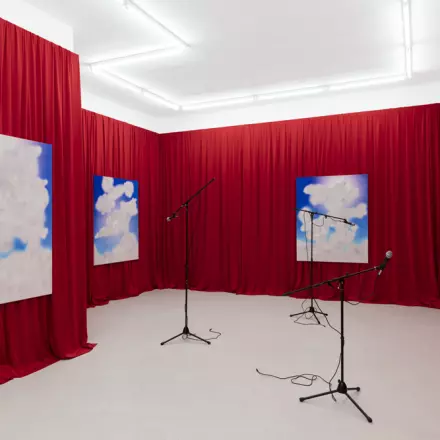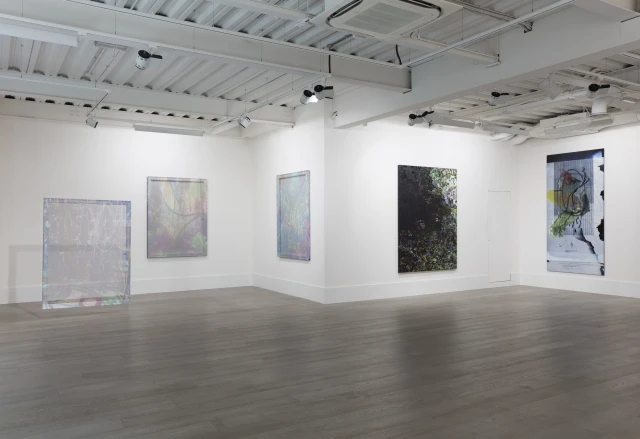Sophia Contemporary is proud to present Im/material: Painting in the Digital Age, a group show of young contemporary artists investigating the nature of painting in today’s digital age. Featuring eight international artists all under the age of forty – Martin Basher, Michael Bell-Smith, Ry David Bradley, Chris Dorland, Matthew Hansel, Anna Ostoya, Josh Reames, and Konrad Wyrebek – the exhibition reflects on the role of painting in a post-internet age where digital imagery is omnipresent. Through varying formal and conceptual strategies, the featured artists question the boundaries of painting at a time when software and machines can replicate the functions of easel, canvas, and paint, and contemporary imagery is increasingly viewed and consumed through computer screens and devices. The exhibition will open to the public with a reception from 6-8PM on Thursday, September 28, and will remain on view through November 17.
The eight artists included in the show all grew up with computers and the internet as ubiquitous media through which images are produced and consumed. All of the artists were chosen for approaching painting as a way to draw attention to and reimagine digitally produced images, slowing them down to examine their meaning and impact, both in relationship to art history and our daily consumption of them. The eighteen works in the exhibition explore subjects including imagery related to advertising, branding, and corporate culture; the flattening of hierarchies between perceived high and low art; the blurred boundaries between the handmade and the technological; and the visual manifestation and capturing of speed as images move through digital frameworks.
Painting has always been influenced by technological advancements: among others, the development of the brush, the compass, the camera obscura, photography, mechanical printing, and the inkjet printer all had an impact on painting. However, it is only recently that painting has become conceptually and aesthetically permeated by digital technologies to a point where the digital and analog realms can sometimes become indistinguishable from one another. Every new era of technological advancements has led to claims of the demise of painting as an outmoded traditional medium to be replaced by new techniques, supports and media. However, painting has always absorbed these new technologies as well as being absorbed by them, thereby becoming a conduit for experimentation and ultimately maintaining its relevance through time.
This shift from analog to digital imagery in the latter half of the 20th century and first half of the 21st century undoubtedly constitutes one of the most important paradigm shifts to take place since the invention of photography in the 19th century. Whether the artists in the show use digital technology as a way to expand the boundaries of painting or as a means to reinterpret its history, they all question its nature and role in order to reinvent it and ultimately reaffirm its conceptual and aesthetic relevance in an ever-changing world.
Martin Basher‘s (b. 1979, New Zealand) paintings and sculptural works investigate the language of contemporary advertising and consumerism while referring to the legacy of Modernism. In his paintings, the artist uses as a starting point digital images of idyllic beaches which he paints with immaculate photo-realistic accuracy. His idiosyncratic gradated stripes are then overlaid on the figurative image or used to create standalone abstract paintings. By overlaying utopian consumerist imagery with the tropes of Modernist geometric abstraction, the artist skilfully blends the registers of high and low art while questioning the seductive powers of commercial imagery in today’s society.
Martin Basher’s works are included in many private and public collections including the The Agnes Gund Collection, NYC, USA; The Art Institute of Chicago, IL, USA; The Chartwell Collection, Auckland, New Zealand; and The James Wallace Collection, Auckland, New Zealand. He currently lives and works in New York City.
Michael Bell-Smith‘s (b. 1978, USA) paintings and videos blend visual elements from games, advertising, interior and corporate design among others to chart the viral proliferation of images in the digital realm and its relation to the material world. Operating at the nexus of painting, collage, drawing, and page design, the artist’s new series of ‘Layout’ paintings are constructed through the use of a vinyl cutter, a machine that cuts digital shapes from sheets of adhesive coloured vinyl. Through this method, the works combine discrete marks in a series of layers that carry the traces of various processes and reproductive technologies, including scanning, image compression, and digital photography, thereby investigating the conversion between the digital and material realms.
Michael Bell-Smith’s work has been exhibited internationally, including at The New Museum, NYC, USA; The Museum of Modern Art, NYC, USA; The Hirshhorn Museum and Sculpture Garden, Washington DC, USA; The Museum of Fine Arts, Lausanne, Switzerland; Tate Liverpool, UK; and The Musée dʼArt Moderne de la Ville de Paris, France, among others. He lives and works in Brooklyn, USA.
Ry David Bradley’s (b. 1979, Australia) process-based practice investigates the nature of painting in an era where the boundaries between picture, video, and virtual reality are increasingly blurred. The artist’s new series of works reproduces images from the technological and natural worlds, which are imprinted on superfine transparent mesh and wrapped on a hand painted frame. Technology and nature thereby merge onto the canvas and slowly dissolve onto one another. Painting becomes a product of technology as much as a conscious act from the artist. USB sticks containing a high definition image of the works are also encased into their frames. Which raises the question: will the paintings outlive their digital representations or will the digital prevail over the material?
Ry David Bradley’s recent institutional exhibitions include ‘Art of the Matter’, Contemporary Art Museum St Louis, MO, USA, 2016; ‘Painting, More Painting’, Australian Centre for Contemporary Art, Melbourne, Australia, 2016; ‘Face to Face’, Palazzo Fruscione, Salerno, Italy, 2016; and ‘Superposition of Three Types’, Artspace Museum, Sydney, Australia, 2016. He lives and works in London, UK.
Chris Dorland‘s (b. 1978, Canada) hallucinatory videos and UV printed paintings explore the logic of consumer society and our increasing co-dependency on technology for both personal and collective experiences. At once humorous, abject, and beautiful, Dorland deploys the scanner and printer as tools to create his paintings. Seemingly random snippets of visual information taken from the worlds of entertainment, advertising, and manufacturing co-exist and interact with the signs and symbols of personal subjectivity. The artist’s hyper-saturated glitch paintings combine archival imagery, industrial materials, and gestural marks and smears. Dorland’s work questions the deeper meaning beneath our consumer-driven lifestyles while exposing the inherent decay in a capitalist society driven by instant gratification and planned obsolescence.
Chris Dorland’s work has been exhibited internationally at institutions such as The Queens Museum of Art, NYC, USA; Museo Nacional De Bellas Artes, Santiago, Chile; White Flag Projects, St-Louis, MO, USA and The Suburban, Oak Park, IL, USA. His work is included in numerous public and private collections, including The Bronx Museum, NYC, USA; The Whitney Museum of Art, NYC, USA; and Neuberger Museum, Purchase NY, USA. The artist lives and works in New York City.
Mathew Hansel‘s (b. 1977, USA) practice playfully assembles varying artistic traditions and tonal registers to create a surreal and immersive visual experience. The artist overlays classical imagery with cartoonesque elements on Photoshop before skilfully painting the computer image onto the canvas. The resulting paintings collapse the boundaries between high and low art and bring to life uncanny trompe l’oeil figures at the confluence of traditional painting and digital wizardry. Using a mixture of humour and pathos, the artist creates post-modern canvases that reflect on the history of painting while exploring the flattening of artistic hierarchies in an age where technology provides a constant stream of unmediated imagery.Hansel’s work has been shown at Gagosian Gallery, Athens, Greece; Yuka Contemporary, Tokyo, Japan; Paul Kasmin Gallery, NYC, USA; The Hole Gallery, NYC, USA; The Lodge Gallery, NYC, USA; Wasserman Projects, Detroit, MI, USA; The Art Center, Martinsburg, WV, USA; Cerasoli Gallery, Culver City, CA, USA; and Hooper Projects, Los Angeles, CA, USA, among others. He lives and works in Brooklyn, USA.
Anna Ostoya‘s (b. Poland, 1978) draws upon the histories and strategies of 20th Century avant-garde movements from Constructivism to Dada, Futurism to Abstract Expressionism, in a bid to activate and revisit works and ideas from the past and imbue them with new meaning. Her varied output – incorporating painting, photography, collage, sculpture and text – tackles social and political challenges such as censorship, the violence of war, and the undervalued role of women in major art movements. Ostoya often uses found images as her source and imposes restrictions on her process – time, materials, formats – as she explores a tension between spontaneity and control. By reinterpreting the traditions of European and American avant-garde through both digital and analog imagery, Ostoya investigates historical hierarchies and narratives while questioning their legacy and relevance in our contemporary world.
Ostoya’s work has been exhibited at institutions such as The Museum of Modern Art, NYC, USA; Kunsthalle, Mulhouse, France; 2015 Lyon Biennale, France; The Power Plant Toronto, Canada; The CCS Bard College, Annandale-On-Hudson, NY, USA; Manifesta 7, Rovereto, Italy and The Second Athens Biennial, Greece. She has had solo exhibitions at La Kunsthalle Mulhouse, France; Foksal Gallery Warsaw, Poland; and CCA Kronika, Bytom, Poland. She lives and works in New York, USA.
Josh Reames‘ (b. 1985, USA) freewheeling paintings use contemporary tools available on the Internet to create surreal patchworks of contemporary signs and symbols that reveal the flattening of artistic hierarchies in our post-modern world. The Surrealist movement advocated the use of automatic drawing and free-association in order to create uncanny collages of disparate elements that would reveal the depth of the human psyche. By using computer drawing applications and mining pictures on Google images in a process similar to the Surrealists, Josh Reames creates playful assemblages of “modern hieroglyphs” that explore his unconscious mind while casting a light on the profusion of images that permeate contemporary culture.
Reames’ work has been shown among others at The Hole, NYC, USA; Johannes Vogt, NYC, USA; Luis de Jesus, Los Angeles, CA, USA; Andrew Rafacz Gallery, Chicago, IL, USA; Josh Lilley Gallery, London, UK; Brand New Gallery, Milan, Italy; Annarumma Gallery, Naples, Italy; Dittrich & Schlechtriem, Berlin, Germany; and Koenig Galerie, Berlin, Germany. He lives and works in Brooklyn, USA.
Konrad Wyrebek‘s (b. Czech Republic) practice encompasses video, installation, performance, sculpture and painting, and explores the boundaries of contemporary imagery and the intrinsic dangers of technology. In his ‘Data Error’ series, the artist captures images from television and the internet and processes them through a succession of digital compressions until he finds a pixelated bug that attracts his attention. Wyrebek then selects the image and crystallizes this split second into layers of paintings. Each layer is realized in turn by a machine and in turn by hand, thereby questioning the role and originality of the artist in a post-modern world where machines could soon replace the human hand and mind.
Wyrebek’s work has been included in several museum shows, including at The Musee Cognacq-Jay, Paris, France; Solyanka Art Museum, Moscow, Russia; Point Zero Project Space, London, UK; Academy and Museum of Contemporary Art, Clifford Chance Collection, London, UK; and CutOut, Sotheby’s Institute of Art, London, UK, among others. He lives and works in London, UK.
 Ry David Bradley
Ry David Bradley 